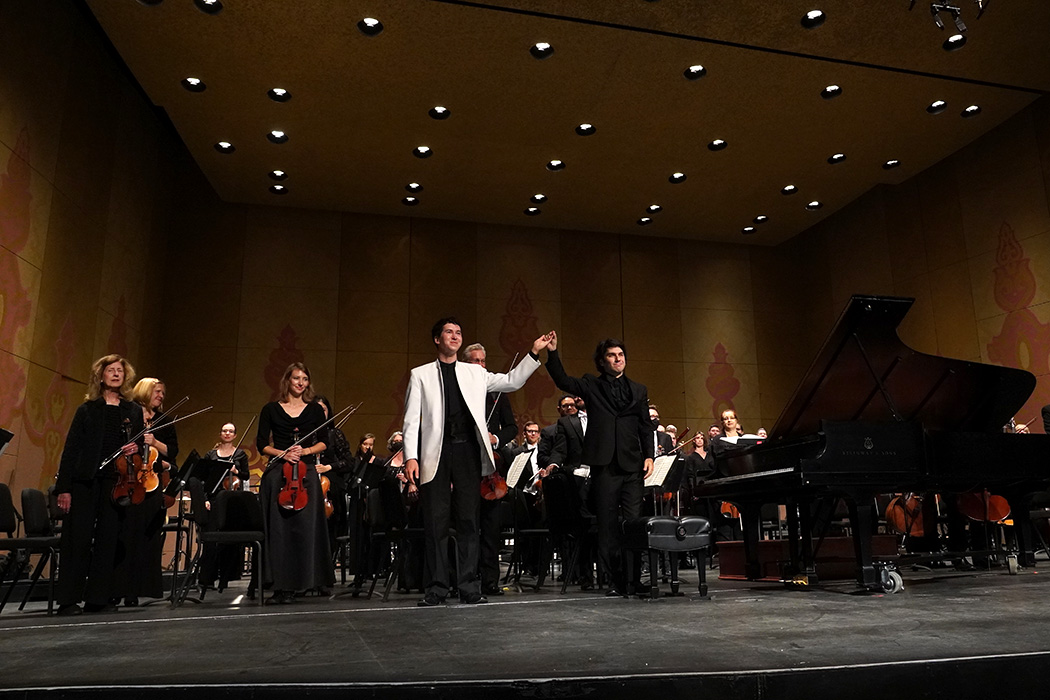The four months of summer break for the Knoxville Symphony Orchestra Masterworks concerts always seems a bit interminable. But there we were—strolling into the Tennessee Theatre lobby feeling that strange sense of excitement that is not unlike the butterflies of apprehension on the first day of school. As usual, welcome-back glasses of champagne were offered in the crush of the arriving crowd, some brass instrumentalists played a fanfare, and the concert was prefaced by The Star Spangled Banner. Those rituals aside, perhaps most important was that Maestro Aram Demirjian and the orchestra were picking up where they left off last May with its musical plan—exciting, unfamiliar pieces from contemporary composers mixed in with classics of the repertoire made fresh by young guest artists and an orchestra performing at the top of its form.
Once again, Demirjian took the opportunity to introduce the local audience to a notable contemporary female composer they may not be familiar with—this time the London-born, American-resident, Anna Clyne. Her 2013 Masquerade, a self-described “roller coaster ride for five minutes,” is exactly that. Its high energy, kinetic romp through orchestral textures, urged on by breathtaking rhythms, was an invigorating opener for the audience and a show of strength for the orchestra.
For many—including this writer—the Edvard Grieg Piano Concerto in A minor never really gets old despite its relative concert hall ubiquity. While the KSO performed it just three years ago, a change in the concert program last month made its inclusion a necessity on the KSO opener. This was fortuitous as it turned out, for it brought the young pianist, Charlie Albright, to Knoxville and the Tennessee Theatre stage for what was a sensational and rewarding take on Grieg’s tuneful classic of mid 19th-Century Romanticism.
The key to the Grieg concerto in the 21st Century lies in finding a fresh point of view, and that is exactly what Albright and Demirjian did. From the opening passage, Albright’s passionate attention to the details of phrases offered nuances that are often glossed over by other pianists. In dynamics, too, Albright created a storyline using massaged tempos and steps of volume that drift off into intense softness, passages that brought the listener forward in their seat in order to catch every note. And, while he didn’t shy away from Grieg’s waves of Romantic emotion in the orchestration, Albright kept the focus on the crisp melodic storytelling throughout.
The cadenza of the opening Allegro molto moderato movement was a feast of emotional playing that has, as its ultimate destination, a flash and bang close that often urges the unwary listener to applaud without restraint, admittedly understandable under the circumstances.
With the KSO audience fully enthralled by Albright’s performance and hungry for more, the pianist offered an ear-opening encore, his own hyper-speed take on “Great Balls of Fire.”

With the Steinway stowed at intermission, Demirjian devoted the second half of the concert to another popular work, Pyotr Ilyich Tchaikovsky’s Symphony No. 4. Although performed regularly and often taken for granted by even major orchestras, this was not an accusation that can be leveled at the KSO. This is the first performance of the symphony by Demirjian during his tenure with the KSO, although it was performed in early 2015 by guest conductor Lawrence Loh. Demirjian, conducting without a score, was obviously intent on giving the work freshness and intensity. And in fact, that is exactly what he achieved. Demirjian moved through the composer’s ideas, moods, and transitions between ideas, with an insistent painterly purpose, an attitude that resulted in the musical conversation between orchestra and audience being one of wit, intellect, and sonic surprises.
The opening movement’s brass fanfare of “fate”, played boldly and luminously by horns (Principal Jeffery Whaley), trumpets (Principal Phillip Chase Hawkins), and trombones (Principal Samuel Chen), sets up the intensity and sense of purpose for what transpires from strings and woodwinds in the long movement. Perhaps because of the beautiful tension and gravity communicated in that first movement, the audience didn’t dare applaud at its conclusion—a sure sign that Demirjian’s intensity was working.
The second slower and more melancholy movement, Andantino, was put into motion by gorgeous passages from Principal oboe Claire Chenette. The Scherzo movement—pizzicato strings remarked upon by insistent woodwinds—was a deliciously troubled dream-like interlude. In the final movement, the fate theme returns with Demirjian and the orchestra moving beyond frustration and melancholy to a harmonic solidity that treated every musical idea with graphic boldness. The weighty conclusion banished any musical cobwebs that may have been lingering—as if to say, “What gray clouds?”
Next for the KSO in the concert hall is their Chamber Classics offering on Sunday, September 25, at the Bijou Theatre, featuring works by Mozart, Caroline Shaw, Ginastera.







